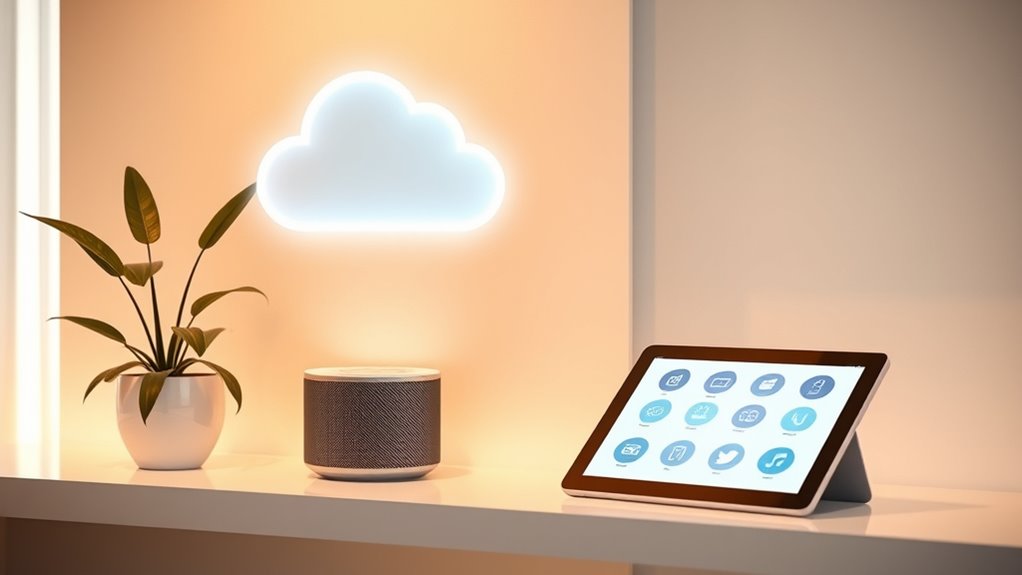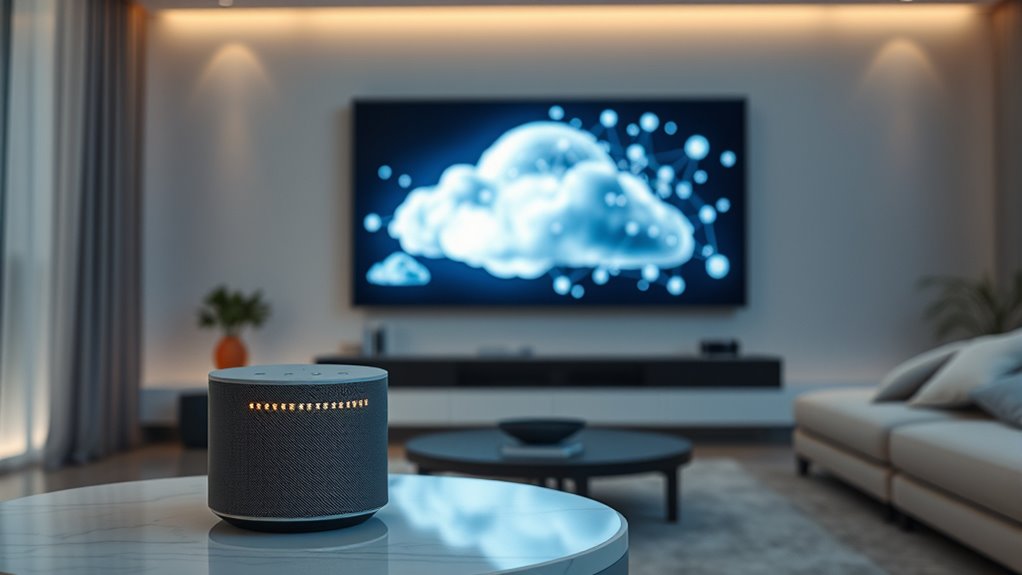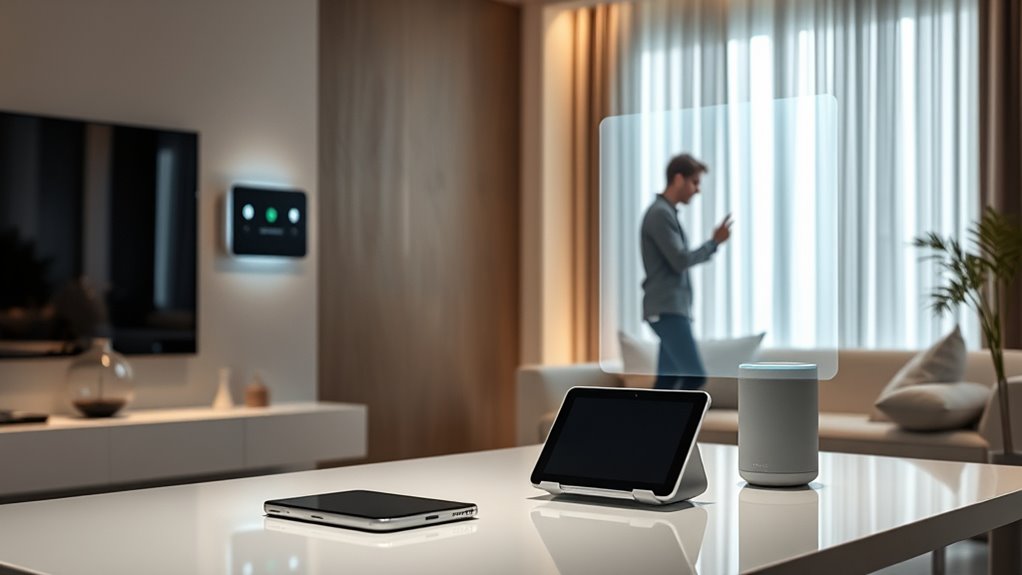By 2025, voice assistants will blend on-device and cloud models to offer smarter, faster, and more personalized experiences while prioritizing your privacy. On-device processing guarantees faster responses, offline use, and better security, whereas cloud solutions support advanced understanding, updates, and seamless integrations. Leading companies are balancing both approaches to enhance functionality without compromising privacy. To discover how these strategies will shape your interactions, explore the evolving landscape further.
Key Takeaways
- On-device voice assistants will offer faster, offline, and privacy-focused interactions with enhanced hardware capabilities.
- Cloud-based models will continue providing advanced NLP, real-time updates, and seamless integration across ecosystems.
- Future models will blend on-device processing with cloud services to optimize speed, privacy, and feature richness.
- Increased IoT and multimedia integration will drive smarter, context-aware, and personalized voice assistant experiences.
- Privacy concerns and regulatory compliance will shape the adoption and development strategies of both on-device and cloud solutions.
Current Market Landscape and Growth Trajectory

The current voice assistant market is experiencing rapid growth, driven by technological advancements and increasing consumer adoption. You’re likely noticing more devices equipped with voice tech, from smartphones to smart home gadgets. Market values are estimated between USD 2.73 billion and 7.35 billion in 2024, with projections reaching USD 14.2 billion by 2032. The overall AI-based virtual assistant market could hit nearly USD 310 billion by 2033. North America dominates, holding around 42.5% of the market, and user numbers in the US are expected to rise to over 157 million by 2026. Steady growth, driven by improved AI, smarter devices, and expanding use cases, signals a vibrant, evolving landscape that’s shaping how you interact with technology daily. Additionally, as voice assistants become more integrated into daily routines, considerations around privacy and security are increasingly important for users and developers alike. Furthermore, advancements in hardware integration, such as on-device processing capabilities, are reducing reliance on cloud services, which may influence future market dynamics. This shift toward on-device processing can also enhance privacy protections and reduce latency in voice interactions. As research and consumer demand push for more on-device AI, it is likely that more voice assistants will incorporate these capabilities to meet expectations for faster and more secure responses.
Core Advantages of On-Device Voice Assistants

On-device voice assistants offer significant privacy benefits by processing your data locally rather than sending it to the cloud. This means your sensitive information stays on your device, reducing exposure risks. Additionally, on-device models deliver faster responses because they don’t rely on internet connectivity. You can also use them offline, which is handy in areas with poor or no network access. The integration of cozy textiles and natural materials in smart home devices can further enhance user comfort and experience. Moreover, the use of advanced hardware components in on-device assistants can improve their overall performance and durability. Given the rapid advancements in AI security measures, on-device assistants are increasingly resilient against potential vulnerabilities. Upgrades such as tuning options for vehicles exemplify how hardware improvements can boost performance and reliability. Furthermore, ongoing privacy protections ensure that user data remains secure and confidential throughout the device’s lifecycle.
Here are three core advantages:
- Enhanced privacy—your data remains on your device.
- Faster response times—less latency improves user experience.
- Offline functionality—use commands even without internet.
These benefits make on-device assistants ideal for privacy-conscious users and situations demanding quick, reliable responses without relying on the cloud.
Benefits and Limitations of Cloud-Based Voice Solutions

Cloud-based voice solutions leverage powerful servers and vast data repositories to deliver advanced AI capabilities, making them highly effective for complex tasks. You benefit from real-time access to extensive information, enabling up-to-date responses and continuous improvements without manual updates. Trustworthy brands have established reliability in this domain, ensuring quality and consistency. Scalability allows seamless integration with third-party services and smart home systems, enhancing functionality. Since processing is handled remotely, you enjoy richer natural language understanding and more natural, conversational interactions. Additionally, cloud solutions can facilitate regular software updates, ensuring features remain current and security measures are enhanced. These updates often incorporate the latest advancements in machine learning and AI, which continually improve system performance. Moreover, the ability to access vast data repositories enhances the AI’s capacity to learn from diverse sources and improve over time. However, these benefits come with limitations. Dependence on internet connectivity can cause delays or service interruptions, and privacy concerns arise from transmitting sensitive data to the cloud. Additionally, reliance on centralized data storage raises security risks, making data breaches a potential threat. Understanding data security and privacy implications is crucial when choosing between cloud and on-device voice solutions. Balancing these advantages and challenges is key to optimizing cloud-based voice solutions for your needs.
Technological Trends Shaping Voice Assistant Innovation by 2025

By 2025, you’ll see voice assistants becoming more natural and conversational thanks to advanced natural language processing. Seamless integration with IoT devices will make your smart environments more responsive and interconnected. Additionally, hyper-personalized experiences will help voice assistants anticipate your needs and tailor interactions uniquely for you. The incorporation of vetted hardware like home theatre projectors will further enhance multimedia interactions within your digital ecosystem. As the market for voice technology continues to grow, developers will prioritize security and user privacy to build trust and widespread adoption. Moreover, ongoing innovations in on-device processing will enable faster responses and increased privacy by reducing dependency on cloud servers. These advancements will also support the expansion of essential oils in daily wellness routines, promoting relaxation and mental clarity in increasingly connected environments. Furthermore, the influence of Bollywood legends and other cultural icons can be seen in the integration of entertainment content within voice assistant interfaces, enriching user experiences.
Advanced Natural Language Processing
Advancements in natural language processing (NLP) are driving a new wave of innovation in voice assistants, making interactions more seamless, intuitive, and context-aware. You’ll notice smarter responses that understand not just words but the intent and emotional tone behind them. Here’s what’s happening:
- Improved context awareness allows your voice assistant to remember previous conversations and provide relevant follow-ups. Personalization techniques are increasingly integrated to enhance user experience. Additionally, understanding emotional support can help voice assistants respond more empathetically in sensitive situations.
- Enhanced language models enable more natural, conversational interactions, making commands feel less robotic.
- Multilingual capabilities let you switch languages effortlessly, broadening accessibility for diverse users.
- Incorporating predictive modeling techniques helps voice assistants anticipate user needs based on prior interactions, further personalizing the experience.
These developments mean your voice assistant can interpret complex queries accurately and respond more like a human, creating a more engaging and personalized experience. The future of NLP promises smarter, more responsive voice tech by 2025.
Seamless IoT Integration
As IoT devices become more embedded in daily life, voice assistants are increasingly designed to seamlessly connect with and control these smart appliances and systems. You’ll notice that integration isn’t just about voice commands but about creating unified ecosystems where devices communicate effortlessly. Developers focus on expanding compatibility across brands and protocols, ensuring you can manage everything from lighting to security systems with minimal effort. Edge computing and smarter APIs enable faster responses and more reliable control, even in complex setups. This seamless connectivity allows for automation and proactive management, making your smart environment more intuitive. By 2025, the goal is to make IoT integration so smooth that controlling your home or office feels natural, effortless, and always within reach through your voice assistant. Additionally, market research helps developers understand evolving user needs and preferences, ensuring that voice assistant integration continues to improve and meet consumer expectations. The integration of cognitive capabilities further enhances the responsiveness and personalization of these systems, creating a more adaptive experience. Moreover, optimizing device interoperability will be essential to achieve truly unified smart environments.
Hyper-Personalized Experiences
Hyper-personalized experiences are transforming how voice assistants serve you by tailoring interactions to your preferences, routines, and contexts. You’ll notice responses becoming more intuitive, anticipating your needs, and adapting to your habits. This shift is driven by advances in AI and NLP, making conversations feel more natural. Here are three ways this trend enhances your experience:
- Custom Recommendations: Your voice assistant will suggest music, news, or shopping options based on your past choices.
- Context Awareness: It understands your environment—like adjusting responses based on location or time of day.
- Proactive Engagement: Expect your assistant to proactively remind you about appointments or medication without being asked.
These advancements make your interactions more seamless, efficient, and personalized, shaping a smarter voice assistant by 2025.
Regulatory and Privacy Challenges in Voice Assistant Deployment

Regulatory and privacy challenges considerably impact the deployment of voice assistants, as companies must navigate a complex landscape of data protection laws and consumer expectations. You need to guarantee compliance with regulations like GDPR and CCPA, which demand transparency about data collection and usage. Privacy concerns are heightened because voice assistants continuously capture sensitive information, raising fears of eavesdropping and data misuse. You also face scrutiny over how data is stored, processed, and shared, especially with cloud-based models that centralize information. Balancing user privacy with service personalization becomes a tightrope walk. Failure to address these issues can lead to legal penalties, loss of consumer trust, and reputational damage. As a result, companies must prioritize privacy-by-design approaches and transparent communication to foster user confidence.
Competitive Strategies of Industry Leaders and Market Players

You’ll see that industry leaders are focusing on personalization and ecosystem integration to stand out in a crowded market. By tailoring experiences and connecting devices seamlessly, they aim to boost user engagement and loyalty. These strategies are shaping how companies compete and innovate in the voice assistant space.
Differentiation Through Personalization
Industry leaders are increasingly focusing on personalization as a key differentiator to capture user loyalty and stand out in the competitive voice assistant market. They understand that tailoring interactions makes users feel understood and engaged. To achieve this, they implement strategies like:
- Collecting user data to refine responses and predict needs more accurately.
- Customizing notifications, suggestions, and routines based on individual habits.
- Using AI to adapt language style, tone, and preferences for a natural experience.
Ecosystem Integration Strategies
Leading companies in the voice assistant market are actively pursuing ecosystem integration to strengthen their competitive edge. They do this by embedding their assistants across a broad range of devices, platforms, and services, creating seamless user experiences. You’ll notice Amazon, Google, and Apple forming strategic partnerships with smart home brands, automotive manufacturers, and app developers. These integrations help lock users into their ecosystems, increasing engagement and brand loyalty. They also leverage cross-platform data to refine personalization and improve AI capabilities. To stay ahead, industry leaders invest heavily in open APIs and developer tools, encouraging third-party customization. This approach guarantees their voice assistants become central hubs in your daily life, making their ecosystems indispensable and difficult to switch from.

As voice assistants become more integral to daily life, balancing on-device and cloud-based models will be essential for maximizing their potential. You’ll need to weigh privacy, speed, and capabilities to choose the right approach. Here’s how to navigate this future:
- Prioritize privacy when sensitive data is involved, leaning toward on-device processing to keep information local.
- Rely on cloud models for complex tasks, updates, and accessing vast data sources, ensuring your assistant stays current and smarter.
- Blend both methods to optimize performance, using on-device for quick, offline commands and cloud for advanced features needing deep learning.
Frequently Asked Questions
How Do On-Device and Cloud Voice Assistants Compare in Energy Consumption?
You’ll find that on-device voice assistants generally consume less energy during use because they process data locally, eliminating the need for constant data transmission. In contrast, cloud-based assistants require significant energy for ongoing data transfer and server processing, which increases overall power consumption. However, advancements in hardware efficiency might narrow this gap, making both models more energy-conscious in the future. Your choice depends on balancing energy use with performance and privacy needs.
What Hardware Advancements Are Needed for More Capable On-Device Voice Assistants?
You need hardware that acts like a nimble gymnast—lightweight yet powerful enough to perform complex routines. Advancements in low-power processors, like neuromorphic chips, will mimic brain functions, boosting speed and efficiency. More integrated AI accelerators, faster memory, and miniaturized sensors will give your on-device assistant the agility to process natural language seamlessly. These innovations will make your voice assistant smarter, faster, and more capable, without sacrificing device portability or privacy.
How Will Emerging AI Technologies Influence the Future of Voice Assistant Models?
Emerging AI technologies will revolutionize voice assistant models by enabling more natural, accurate, and context-aware interactions. You’ll see smarter assistants that understand nuanced commands, adapt to your preferences, and provide personalized responses. These advancements will also improve offline capabilities and reduce latency, making interactions seamless. As AI continues evolving, voice assistants will become even more integral to your daily life, offering smarter, more intuitive, and secure experiences across devices and environments.
What Are the Primary Security Concerns Specific to On-Device Voice Assistants?
You might worry about the shadows lurking behind on-device voice assistants. Privacy risks include unauthorized access if your device isn’t well secured, or malware that could exploit vulnerabilities. Data stored locally could still be compromised through physical theft or hacking. Also, firmware updates might introduce hidden risks. Staying vigilant, keeping software current, and using strong security measures can help shield your device from these silent threats.
How Can Hybrid Models Optimize User Experience and Privacy Simultaneously?
You can optimize user experience and privacy by combining on-device processing with cloud capabilities. Use on-device features for privacy-sensitive tasks, ensuring data stays local and reducing latency. Meanwhile, leverage cloud services for complex queries and updates, keeping interactions seamless. This hybrid approach balances quick, private responses with access to powerful AI, letting you enjoy personalized, efficient voice assistance without compromising your data security or experience quality.
Conclusion
By 2025, you’ll find voice assistants evolving like a symphony, balancing on-device speed and cloud intelligence. Embracing both models lets you enjoy faster responses and enhanced privacy, but be prepared for ongoing regulatory and technological shifts. Staying adaptable is key, much like steering a river’s changing currents. Ultimately, combining on-device and cloud solutions will shape a smarter, more personalized voice experience that fits seamlessly into your daily life.









